Recent Papers
Full Paper J. Braz. Chem. Soc. 2026
Metabolomics-Driven Identification of Resistance Biomarkers in Dwarf Cashew (Anacardium occidentale L.) under Black Mold Stress
João G. da Cruz  ; Jhonyson A. C. Guedes
; Jhonyson A. C. Guedes  ; Gisele S. da Silva
; Gisele S. da Silva  ; Lorena M. A. e Silva
; Lorena M. A. e Silva  ; Paulo R. V. Ribeiro
; Paulo R. V. Ribeiro  ;
;
Marlon V. V. Martins  ; Debora B. de Sousa
; Debora B. de Sousa  ; Alvaro Luis L. Cassago
; Alvaro Luis L. Cassago  ; Guilherme J. Zocolo
; Guilherme J. Zocolo
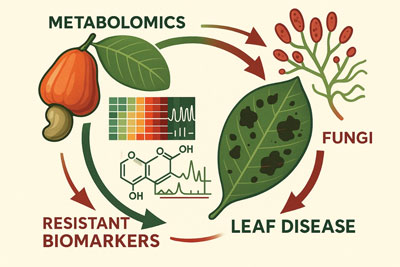
Metabolomics analysis revealed resistance-associated biomarkers in dwarf cashew genotypes under black mold stress caused by leaf pathogenic fungi. This approach highlights key metabolic pathways linked to plant defense.
https://dx.doi.org/10.21577/0103-5053.20250178
J. Braz. Chem. Soc. 2026
Sapientrione, a Tricarbonylated Nor-triterpene with a New Carbon Skeleton from the Roots of Sapium glandulosum (Euphorbiaceae)
Nikole D. T. Lira  ; Anauara L. Silva
; Anauara L. Silva  ; Lucas H. Martorano
; Lucas H. Martorano  ; Carlos V. A. Silva
; Carlos V. A. Silva  ; Maria E. G. Freitas
; Maria E. G. Freitas  ;
;
Valnês S. Rodrigues-Junior  ; Fernando M. dos Santos Jr.
; Fernando M. dos Santos Jr.  ; Lucas S. Abreu
; Lucas S. Abreu  ; Maria F. Agra
; Maria F. Agra  ; Raimundo Braz-Filho
; Raimundo Braz-Filho  ;
;
Marcelo S. Silva  ; Josean F. Tavares
; Josean F. Tavares
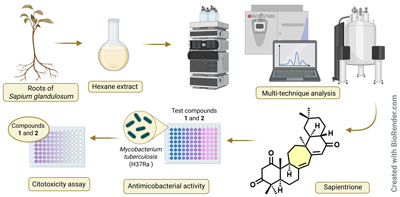
Sapientrione (1), a nor-triterpene with an unprecedented skeleton type was isolated from the roots of Sapium glandulosum (Euphorbiaceae). The antimycobacterial activity and cytotoxicity of the new compound (1) and its derivative (2) were evaluated.
https://dx.doi.org/10.21577/0103-5053.20250177
J. Braz. Chem. Soc. 2026
A Chemometric Method to Quickly and Efficiently Guarantee the Authenticity of Commercialized Cigarettes in Brazil
Lucas S. Rodrigues  ; Carlos G. Massone
; Carlos G. Massone  ; José Marcus de O. Godoy
; José Marcus de O. Godoy

This study aimed to develop an alternative chemometric method to establish the origin of cigarette brands sold in Brazil.
https://dx.doi.org/10.21577/0103-5053.20250175
J. Braz. Chem. Soc. 2026
Enhancement of Thermal Sensitivity of MOF-5 Doped with Eu3+ and Addition of Mn2+
Luanda A. do Nascimento  ; Sanderson H. S. Malta; Ricardo Maia Junior; Severino Alves Júnior
; Sanderson H. S. Malta; Ricardo Maia Junior; Severino Alves Júnior  ; Oscar L. Malta
; Oscar L. Malta

This work explores the metal-organic frameworks (MOF-5) doped with Eu and EuMn as a temperature sensor in the range between 229-393 K.
https://dx.doi.org/10.21577/0103-5053.20250174
J. Braz. Chem. Soc. 2026
Zinc Bismuthate-Based Nanocomposites: Promising Antimicrobial Properties for Biomedical Applications
Felipe R. Silva  ; Edson T. de Jesus
; Edson T. de Jesus  ; Mayara C. Sá
; Mayara C. Sá  ; Margaret Dawson
; Margaret Dawson  ; Thaynara R. Santos
; Thaynara R. Santos  ; Alan S. de Menezes
; Alan S. de Menezes  ;
;
Clenilton C. dos Santos  ; Ulisses M. Nascimento
; Ulisses M. Nascimento  ; Érima J. M. Castro
; Érima J. M. Castro  ; Rita de Cássia M. de Miranda
; Rita de Cássia M. de Miranda  ;
;
Roman A. Roca  ; Antônio E. M. Paiva
; Antônio E. M. Paiva  ; Eliane R. de Sousa
; Eliane R. de Sousa  ; José Hilton G. Rangel
; José Hilton G. Rangel  ; Gilmar S. da Silva
; Gilmar S. da Silva
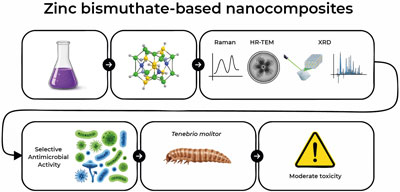
Zinc bismuthate-based nanocomposites synthesized by a hydrothermal route exhibited selective antimicrobial activity and moderate toxicity, highlighting their potential for biomedical applications.
https://dx.doi.org/10.21577/0103-5053.20250173
J. Braz. Chem. Soc. 2026
Unravelling Sources of BPA Exposure in Southern Brazil: Contributions of Drinking Water and Thermal Paper to Daily Intake Assessment through Human Biomonitoring
Camila F. de Souza  ; Giovana P. Peteffi
; Giovana P. Peteffi  ; Marcos F. Bastiani
; Marcos F. Bastiani  ; Amanda P. Bondan
; Amanda P. Bondan  ; Giovanna S. Grassi
; Giovanna S. Grassi  ; Lilian L. F. Lizot
; Lilian L. F. Lizot  ; Roberta Z. Hahn
; Roberta Z. Hahn  ; Marina V. Antunes
; Marina V. Antunes  ; Rafael Linden
; Rafael Linden
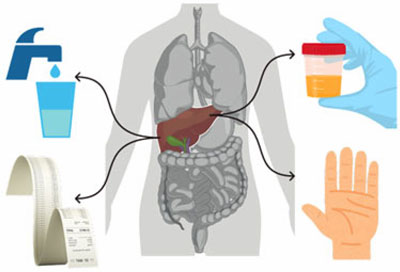
Exposure routes to bisphenol A from drinking water and thermal paper, with urinary excretion as a biomarker.
https://dx.doi.org/10.21577/0103-5053.20250172
J. Braz. Chem. Soc. 2026
Method-Driven Variability in the Volatile Terpene Profile of Mikania sp. and Its Implications for Insect-Plant Interactions in Chemical Ecology
Isabelle Zilli  ; Paulo H. G. Zarbin
; Paulo H. G. Zarbin
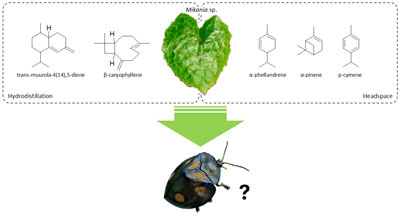
This graphical abstract illustrates how extraction methodology can alter the perceived volatile profile of Mikania sp. The resulting chemical message can directly influence which cues are available to insects, highlighting that methodological choice is critical in chemical ecology studies.
https://dx.doi.org/10.21577/0103-5053.20250171
J. Braz. Chem. Soc. 2026
Promoting Osteoblast Proliferation and Activity by Combining Natural Rubber Hybrid Systems with Calcium Phosphate and Silica Particles
Luciana M. da Silva  ; Rodney M. do Nascimento
; Rodney M. do Nascimento  ; Naiara C. Oliveira
; Naiara C. Oliveira  ; Beatriz O. Lopes
; Beatriz O. Lopes  ; Ana Caroline R. M. Leite
; Ana Caroline R. M. Leite  ;
;
Mirna M. Bezerra  ; Renata F. C. Leitão
; Renata F. C. Leitão  ; Francisco Airton C. da Rocha
; Francisco Airton C. da Rocha  ; Amauri J. de Paula
; Amauri J. de Paula  ; Virgínia C. C. Girão-Carmona
; Virgínia C. C. Girão-Carmona
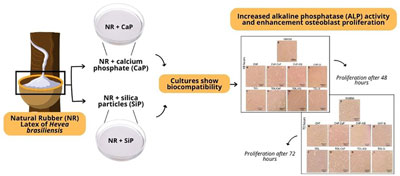
Development and analysis of the influence of hybrid natural rubber (NR) systems, incorporated with CaP and SiP, on the morphology, enzymatic activity (alkaline phosphatase) and viability (3-(4,5-dimethylthiazol-2-yl)-2,5-diphenyl tetrazolium bromide (MTT) assay) of murine osteoblasts.
https://dx.doi.org/10.21577/0103-5053.20250170
J. Braz. Chem. Soc. 2026
Synthesis and Characterization of Sustainable Hydrochar from Banana Peels for the Removal of Iron and Manganese Ions in Aqueous Systems
Marcela O. B. Cortez  ; Karina S. da Silva
; Karina S. da Silva  ; Luísa F. M. Mazzini
; Luísa F. M. Mazzini  ; Ueslei G. Favero
; Ueslei G. Favero  ; Leonarde N. Rodrigues
; Leonarde N. Rodrigues  ;
;
Renê C. da Silva  ; Maria do Carmo Hespanhol
; Maria do Carmo Hespanhol  ; Leandro R. de Lemos
; Leandro R. de Lemos  ; Renata P. L. Moreira
; Renata P. L. Moreira
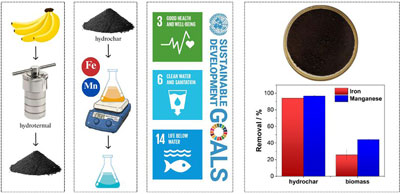
Hydrothermally carbonized hydrochar from banana peel for the removal of iron and manganese from water.
https://dx.doi.org/10.21577/0103-5053.20250169
J. Braz. Chem. Soc. 2026
PVA Films with Carbonized Kraft Lignin: Physico-Chemical Properties and Application in Gas Detection
Lucas Victor B. V. Fré  ; Amanda S. M. de Freitas
; Amanda S. M. de Freitas  ; Jéssica S. Rodrigues
; Jéssica S. Rodrigues  ; André Vitor S. Simõis
; André Vitor S. Simõis  ; Daniel Komatsu
; Daniel Komatsu  ;
;
Vinicius Jessé R. de Oliveira  ; Clarissa A. Olivati
; Clarissa A. Olivati  ; Marystela Ferreira
; Marystela Ferreira

Polyvinyl alcohol (PVA) associated with carbonized Kraft lignin produced in four ratios (0, 10, 30, and 50%), characterizations and application as gas detector.
https://dx.doi.org/10.21577/0103-5053.20250168
J. Braz. Chem. Soc. 2026
Performance of a Molecularly Imprinted Bifunctional Adsorbent Poly(methacrylic acid-phenyltrimetoxysilane) for High-Throughput Solid Phase Extraction of Diuron in Waters and Soymilk Samples
Daniel M. Nanicuacua; Rafael J. Leal  ; Maria Cristina Solci
; Maria Cristina Solci  ; Maikon Thiago do Nascimento; Diego P. dos Santos;
; Maikon Thiago do Nascimento; Diego P. dos Santos;
César Ricardo T. Tarley  ; Mariana G. Segatelli
; Mariana G. Segatelli

Extraction and preconcentration of diuron in environmental waters and soymilk samples using a bifunctional hybrid molecularly imprinted polymer (BHMIP) as a selective adsorbent in solid phase extraction (SPE) followed by high-performance liquid chromatography with diode array detector (HPLC-DAD) determination.
https://dx.doi.org/10.21577/0103-5053.20250167
Online version ISSN 1678-4790 Printed version ISSN 0103-5053
Journal of the Brazilian Chemical Society
JBCS Editorial and Publishing Office
University of Campinas - UNICAMP
13083-970 Campinas-SP, Brazil
Free access









